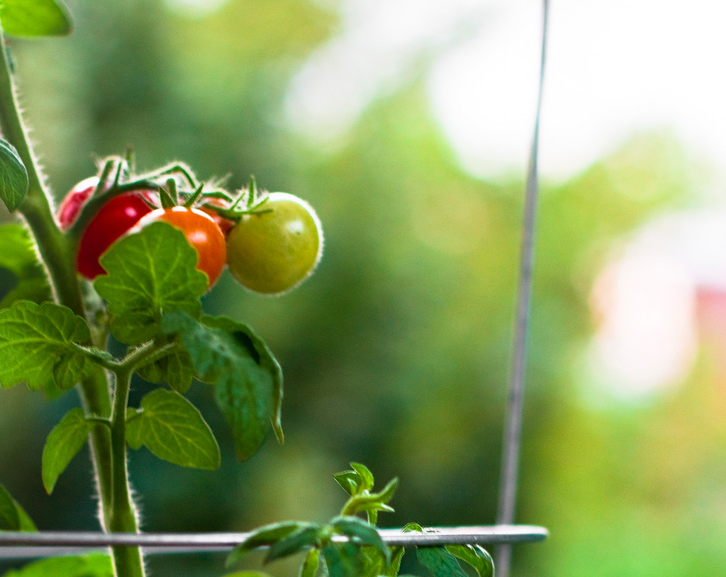(image)
A single tomato plant can produce up to fifteen pounds of tomatoes. Fifteen pounds! In my experience, I have also found that a single tomato plant, whatever poundage it produces, can make you very, very happy. Watching even a handful of tomatoes go from green to yellow to orange to RED RED RED makes you feel like a farmer.
Besides the amazing, unmatchable deliciousness that is a home grown tomato, there’s another reason tomatoes are the most popular vegetable in home gardens: they’re easy to grow. They need just the basics — sunlight, water, and a little bit of fertilizer. And then just one more thing. Structural support. Give them a cage or a stake or a trellis — that’s all they ask, just a little support — and in return, they’ll lavish you with tomato riches and a profound sense of accomplishment. What a deal!
Should you care for more down and dirty details (How big should your container be? How often should you fertilize? Water? How much water??), I’ve got your answers after the jump.
Q: What types of tomatoes can I plant in a container?
A: Any type! You can go for the most gargantuan of heirloom tomatoes if you’ve got the ambition. If you fear an attack of killer tomatoes on your teeny tiny terrace, a dwarf or “patio” variety might suit you best. A few great varieties to consider: Pixie, Tiny Tim, Toy Boy, or Small Fry. The names alone are enough to convince me. If you still have your heart set on the big boys, check back later this week for the full story on lovely, luscious heirlooms.
Q: How much light, water, and fertilizer? I want specifics.
A: Let’s start with light. Six to eight hours a day. If the only sunny spot you’ve got is indoors, that will work too! Just make sure to shake the plants when they flower to spread the pollen, since bees and wind aren’t doing it for you. Moving on to water. In a container in the heat of summer, you’re probably going to need to water every day. Obviously, if it rains, you get the day off. As with pretty much every vegetable, you need good drainage, so make sure there are holes in the bottom of your container. Fertilizer-wise, the easiest thing to do is to start with potting soil that already has fertilizer in it. In my garden, I use either a Miracle-Gro potting soil with six-months worth of fertilizer in it (so they say) or soil from the Lower East Side Ecology Center which has a nice helping of compost mixed in. When the tomato plants start to fruit, you can give them another helping of fertilizer, like this tomato-specific one. If you read the fertilizer label, it’ll tell you to fertilize every week. In my experience, that’s unnecessary.
Q: How big should my tomato container be?
A: Think big. Bigger containers don’t dry out as quickly, so your tomato plant won’t suffer if you have to rush off to work and don’t have time to water it some morning. But most of all, bigger containers will give the tomato roots room to thrive. Smaller containers can limit root growth, which in turn stunts plant growth. You should be looking at four to five gallon containers. Though you can get away with something a little smaller if you pick one of the cute dwarf tomato varieties.
Q: What type of tomato support is best?
A: If you cage it, you can forget it. Staking, the other major alternative, requires you to regularly tie the stem to the stake as the tomato plant gets taller. Not a bad job (I love the smell of tomato plants and how it lingers on your hands after you touch them), just one that requires some attention. Perhaps you think most tomato cages are hideous, as do I. Good news, I’m going to present you with a host of relatively attractive options! Check back later this week for the goodies.

One Comment